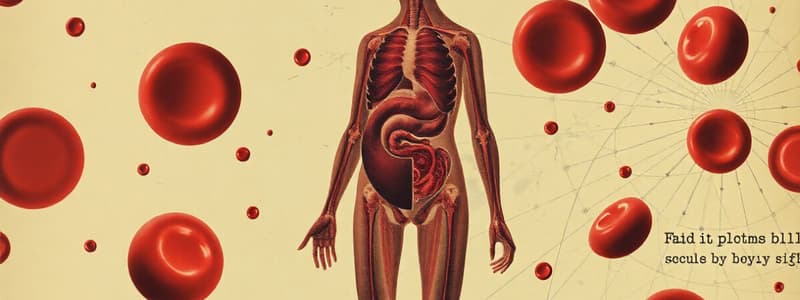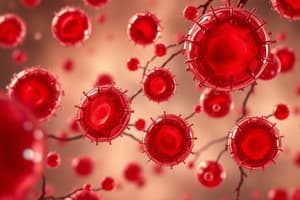Podcast
Questions and Answers
Which of the following scenarios would be MOST affected by a deficiency in platelets?
Which of the following scenarios would be MOST affected by a deficiency in platelets?
- Transporting oxygen to muscle cells during exercise.
- Forming a blood clot after a deep cut. (correct)
- Maintaining a stable body temperature during extreme weather.
- Fighting off a viral infection, such as the flu.
A patient has a condition that impairs their bone marrow function, resulting in a decreased production of all blood cells. Which combination of symptoms would you expect to observe in this patient?
A patient has a condition that impairs their bone marrow function, resulting in a decreased production of all blood cells. Which combination of symptoms would you expect to observe in this patient?
- Impaired oxygen transport, excessive blood clotting, and decreased risk of infection.
- Increased risk of infection, reduced blood clotting ability, and impaired oxygen transport. (correct)
- Reduced blood clotting ability, increased oxygen transport, and decreased inflammation.
- Increased risk of infection, impaired oxygen transport, and excessive blood clotting.
What is the primary distinction between the roles of leukocytes and platelets in maintaining bodily health?
What is the primary distinction between the roles of leukocytes and platelets in maintaining bodily health?
- Leukocytes are responsible for transporting nutrients, while platelets are responsible for oxygen transport.
- Leukocytes are involved in blood clotting, while platelets defend against pathogens.
- Leukocytes defend against pathogens, while platelets are involved in blood clotting. (correct)
- Leukocytes transport oxygen, while platelets are responsible for fighting infections.
How would the absence of platelets impact the function of erythrocytes and leukocytes?
How would the absence of platelets impact the function of erythrocytes and leukocytes?
Why are leukocytes characterized by having a nucleus, unlike some other blood components?
Why are leukocytes characterized by having a nucleus, unlike some other blood components?
If a patient has a lower than normal level of glucose in their plasma, which bodily function might be directly affected?
If a patient has a lower than normal level of glucose in their plasma, which bodily function might be directly affected?
How does the binding and release of oxygen and carbon dioxide by hemoglobin contribute to the color variation observed in blood?
How does the binding and release of oxygen and carbon dioxide by hemoglobin contribute to the color variation observed in blood?
What is the primary role of red blood cells in the context of gas exchange within the body?
What is the primary role of red blood cells in the context of gas exchange within the body?
Why is the absence of nuclei in red blood cells advantageous for their function?
Why is the absence of nuclei in red blood cells advantageous for their function?
A blood sample contains a normal amount of red blood cells but a decreased amount of plasma. What would be the likely effect of this?
A blood sample contains a normal amount of red blood cells but a decreased amount of plasma. What would be the likely effect of this?
Which of the following accurately describes the roles of plasma and red blood cells in maintaining homeostasis?
Which of the following accurately describes the roles of plasma and red blood cells in maintaining homeostasis?
If a patient's tissues are not receiving enough oxygen, which component of the blood is most likely not functioning properly?
If a patient's tissues are not receiving enough oxygen, which component of the blood is most likely not functioning properly?
How would the blood's function be compromised if red blood cells had nuclei?
How would the blood's function be compromised if red blood cells had nuclei?
Flashcards
Leukocytes
Leukocytes
Blood cells that defend the body against pathogens and neutralize toxins.
Platelets
Platelets
Cellular fragments in blood, formed in bone marrow, that initiate blood clotting and wound healing.
Function of Leukocytes
Function of Leukocytes
To trap pathogens, destroy them, and neutralize toxins.
Function of Platelets
Function of Platelets
Signup and view all the flashcards
Plasma
Plasma
Signup and view all the flashcards
Blood Plasma
Blood Plasma
Signup and view all the flashcards
Red Blood Cells (Erythrocytes)
Red Blood Cells (Erythrocytes)
Signup and view all the flashcards
Hemoglobin
Hemoglobin
Signup and view all the flashcards
Oxyhemoglobin
Oxyhemoglobin
Signup and view all the flashcards
White Blood Cells (Leukocytes)
White Blood Cells (Leukocytes)
Signup and view all the flashcards
Oxygen Transfer (Lungs to Blood)
Oxygen Transfer (Lungs to Blood)
Signup and view all the flashcards
Oxygen Transfer (Blood to Tissues)
Oxygen Transfer (Blood to Tissues)
Signup and view all the flashcards
Study Notes
Blood and its Composition
- Blood has a red color.
- The red color comes from red cells
- Blood also includes a yellowish liquid, plasma
- Blood is composed of plasma and cells that can be classified into three categories
- Red blood cells also known as erythrocytes
- White blood cells also known as leukocytes
- Platelets
Plasma
- Plasma is the liquid part of the blood
- Plasma consists primarily of water
- Dissolved substances make up 10% of the plasma volume
- Includes nutrients like glucose
- Proteins
- Vitamins
- Fats
- Substances for elimination
- Glucose makes up 2% of the plasma, it's absorbed from the small intestine and transported to cells for required energy.
Red Blood Cells (Erythrocytes)
- Red blood cells are plentiful.
- A drop of blood contains millions of erythrocytes
- They are small in size and lack a nucleus
- Their cytoplasm contains hemoglobin, which gives them distinct red color
- Hemoglobin is a specialized protein that binds to oxygen
- When erythrocytes reach the lungs, they take in oxygen, becoming oxyhemoglobin
- Erythrocytes transport oxygen to tissues and cells where it's released
- After releasing oxygen, hemoglobin binds to carbon dioxide
- Hemoglobin with carbon dioxide gives blood a dark red color
- Hemoglobin with oxygen gives blood a bright red color
White Blood Cells (Leukocytes)
- Most blood cells have a red color, while the rest are white.
Studying That Suits You
Use AI to generate personalized quizzes and flashcards to suit your learning preferences.



